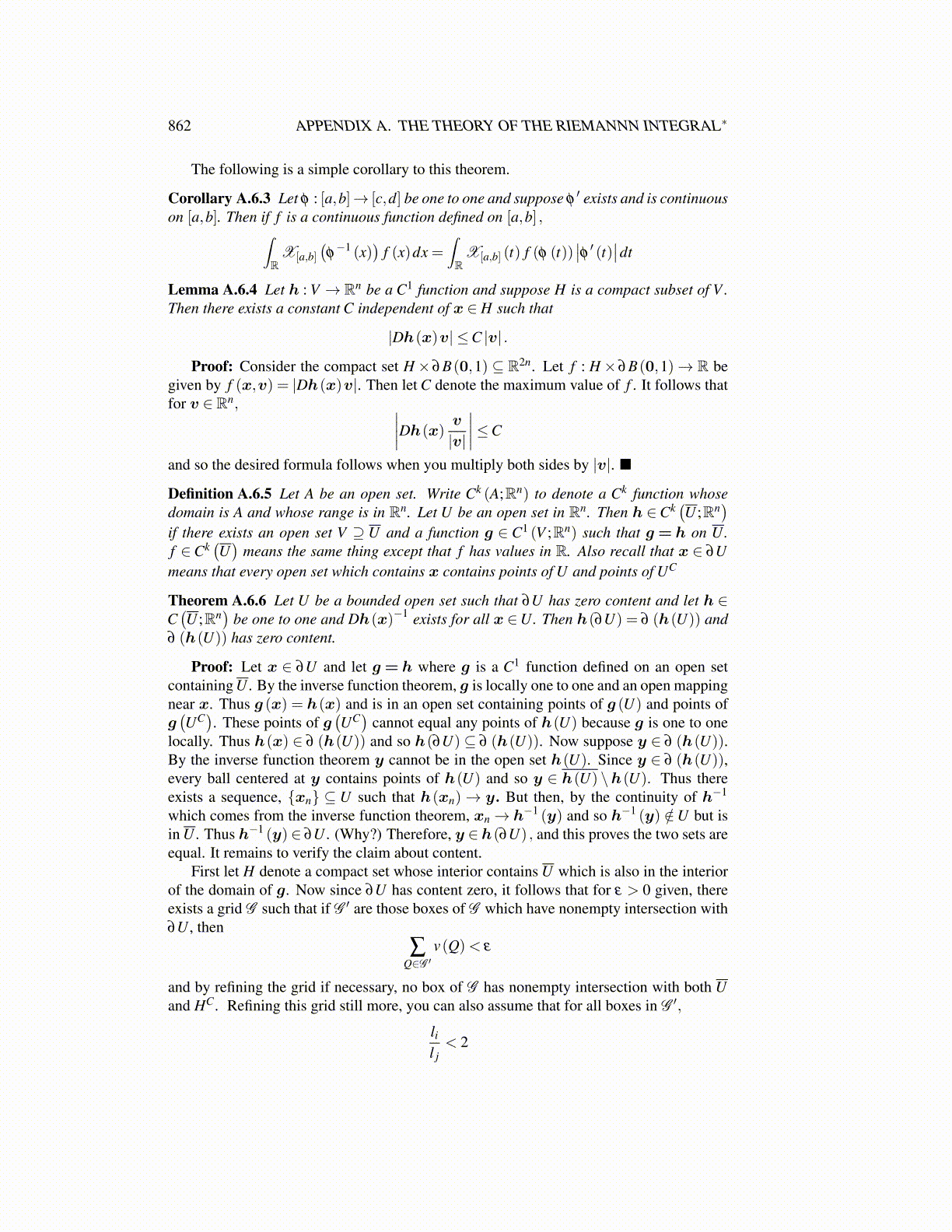
862 APPENDIX A. THE THEORY OF THE RIEMANNN INTEGRAL∗
The following is a simple corollary to this theorem.
Corollary A.6.3 Let φ : [a,b]→ [c,d] be one to one and suppose φ′ exists and is continuous
on [a,b]. Then if f is a continuous function defined on [a,b] ,∫R
X[a,b](φ−1 (x)
)f (x)dx =
∫R
X[a,b] (t) f (φ (t))∣∣φ ′ (t)∣∣dt
Lemma A.6.4 Let h : V → Rn be a C1 function and suppose H is a compact subset of V .Then there exists a constant C independent of x ∈ H such that
|Dh(x)v| ≤C |v| .
Proof: Consider the compact set H× ∂B(0,1) ⊆ R2n. Let f : H× ∂B(0,1)→ R begiven by f (x,v) = |Dh(x)v|. Then let C denote the maximum value of f . It follows thatfor v ∈ Rn, ∣∣∣∣Dh(x)
v
|v|
∣∣∣∣≤C
and so the desired formula follows when you multiply both sides by |v|. ■
Definition A.6.5 Let A be an open set. Write Ck (A;Rn) to denote a Ck function whosedomain is A and whose range is in Rn. Let U be an open set in Rn. Then h ∈Ck
(U ;Rn
)if there exists an open set V ⊇ U and a function g ∈ C1 (V ;Rn) such that g = h on U.f ∈Ck
(U)
means the same thing except that f has values in R. Also recall that x ∈ ∂Umeans that every open set which contains x contains points of U and points of UC
Theorem A.6.6 Let U be a bounded open set such that ∂U has zero content and let h ∈C(U ;Rn
)be one to one and Dh(x)−1 exists for all x ∈U. Then h(∂U) = ∂ (h(U)) and
∂ (h(U)) has zero content.
Proof: Let x ∈ ∂U and let g = h where g is a C1 function defined on an open setcontaining U . By the inverse function theorem, g is locally one to one and an open mappingnear x. Thus g (x) = h(x) and is in an open set containing points of g (U) and points ofg(UC). These points of g
(UC)
cannot equal any points of h(U) because g is one to onelocally. Thus h(x) ∈ ∂ (h(U)) and so h(∂U) ⊆ ∂ (h(U)). Now suppose y ∈ ∂ (h(U)).By the inverse function theorem y cannot be in the open set h(U). Since y ∈ ∂ (h(U)),every ball centered at y contains points of h(U) and so y ∈ h(U) \h(U). Thus thereexists a sequence, {xn} ⊆ U such that h(xn)→ y. But then, by the continuity of h−1
which comes from the inverse function theorem, xn→ h−1 (y) and so h−1 (y) /∈U but isin U . Thus h−1 (y) ∈ ∂U . (Why?) Therefore, y ∈ h(∂U) , and this proves the two sets areequal. It remains to verify the claim about content.
First let H denote a compact set whose interior contains U which is also in the interiorof the domain of g. Now since ∂U has content zero, it follows that for ε > 0 given, thereexists a grid G such that if G ′ are those boxes of G which have nonempty intersection with∂U , then
∑Q∈G ′
v(Q)< ε
and by refining the grid if necessary, no box of G has nonempty intersection with both Uand HC. Refining this grid still more, you can also assume that for all boxes in G ′,
lil j
< 2